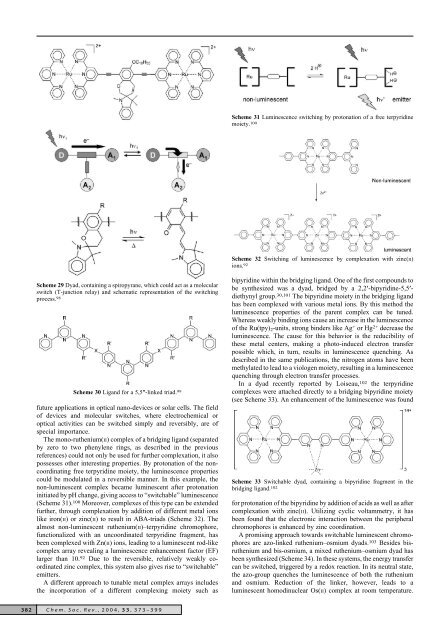Digital version
Digital version
Digital version
You also want an ePaper? Increase the reach of your titles
YUMPU automatically turns print PDFs into web optimized ePapers that Google loves.
382<br />
Scheme 29 Dyad, containing a spiropyrane, which could act as a molecular<br />
switch (T-junction relay) and schematic representation of the switching<br />
process. 98<br />
Scheme 30 Ligand for a 5,5B-linked triad. 99<br />
future applications in optical nano-devices or solar cells. The field<br />
of devices and molecular switches, where electrochemical or<br />
optical activities can be switched simply and reversibly, are of<br />
special importance.<br />
The mono-ruthenium(II) complex of a bridging ligand (separated<br />
by zero to two phenylene rings, as described in the previous<br />
references) could not only be used for further complexation, it also<br />
possesses other interesting properties. By protonation of the noncoordinating<br />
free terpyridine moiety, the luminescence properties<br />
could be modulated in a reversible manner. In this example, the<br />
non-luminescent complex became luminescent after protonation<br />
initiated by pH change, giving access to “switchable” luminescence<br />
(Scheme 31). 100 Moreover, complexes of this type can be extended<br />
further, through complexation by addition of different metal ions<br />
like iron(II) or zinc(II) to result in ABA-triads (Scheme 32). The<br />
almost non-luminescent ruthenium(II)–terpyridine chromophore,<br />
functionalized with an uncoordinated terpyridine fragment, has<br />
been complexed with Zn(II) ions, leading to a luminescent rod-like<br />
complex array revealing a luminescence enhancement factor (EF)<br />
larger than 10. 92 Due to the reversible, relatively weakly coordinated<br />
zinc complex, this system also gives rise to “switchable”<br />
emitters.<br />
A different approach to tunable metal complex arrays includes<br />
the incorporation of a different complexing moiety such as<br />
Chem. Soc. Rev., 2004, 33, 373–399<br />
Scheme 31 Luminescence switching by protonation of a free terpyridine<br />
moiety. 100<br />
Scheme 32 Switching of luminescence by complexation with zinc(II)<br />
ions. 92<br />
bipyridine within the bridging ligand. One of the first compounds to<br />
be synthesized was a dyad, bridged by a 2,2A-bipyridine-5,5Adiethynyl<br />
group. 30,101 The bipyridine moiety in the bridging ligand<br />
has been complexed with various metal ions. By this method the<br />
luminescence properties of the parent complex can be tuned.<br />
Whereas weakly binding ions cause an increase in the luminescence<br />
of the Ru(tpy)2-units, strong binders like Ag + or Hg 2+ decrease the<br />
luminescence. The cause for this behavior is the reducibility of<br />
these metal centers, making a photo-induced electron transfer<br />
possible which, in turn, results in luminescence quenching. As<br />
described in the same publications, the nitrogen atoms have been<br />
methylated to lead to a viologen moiety, resulting in a luminescence<br />
quenching through electron transfer processes.<br />
In a dyad recently reported by Loiseau, 102 the terpyridine<br />
complexes were attached directly to a bridging bipyridine moiety<br />
(see Scheme 33). An enhancement of the luminescence was found<br />
Scheme 33 Switchable dyad, containing a bipyridine fragment in the<br />
bridging ligand. 102<br />
for protonation of the bipyridine by addition of acids as well as after<br />
complexation with zinc(II). Utilizing cyclic voltammetry, it has<br />
been found that the electronic interaction between the peripheral<br />
chromophores is enhanced by zinc coordination.<br />
A promising approach towards switchable luminescent chromophores<br />
are azo-linked ruthenium–osmium dyads. 103 Besides bisruthenium<br />
and bis-osmium, a mixed ruthenium–osmium dyad has<br />
been synthesized (Scheme 34). In these systems, the energy transfer<br />
can be switched, triggered by a redox reaction. In its neutral state,<br />
the azo-group quenches the luminescence of both the ruthenium<br />
and osmium. Reduction of the linker, however, leads to a<br />
luminescent homodinuclear Os(II) complex at room temperature.

















